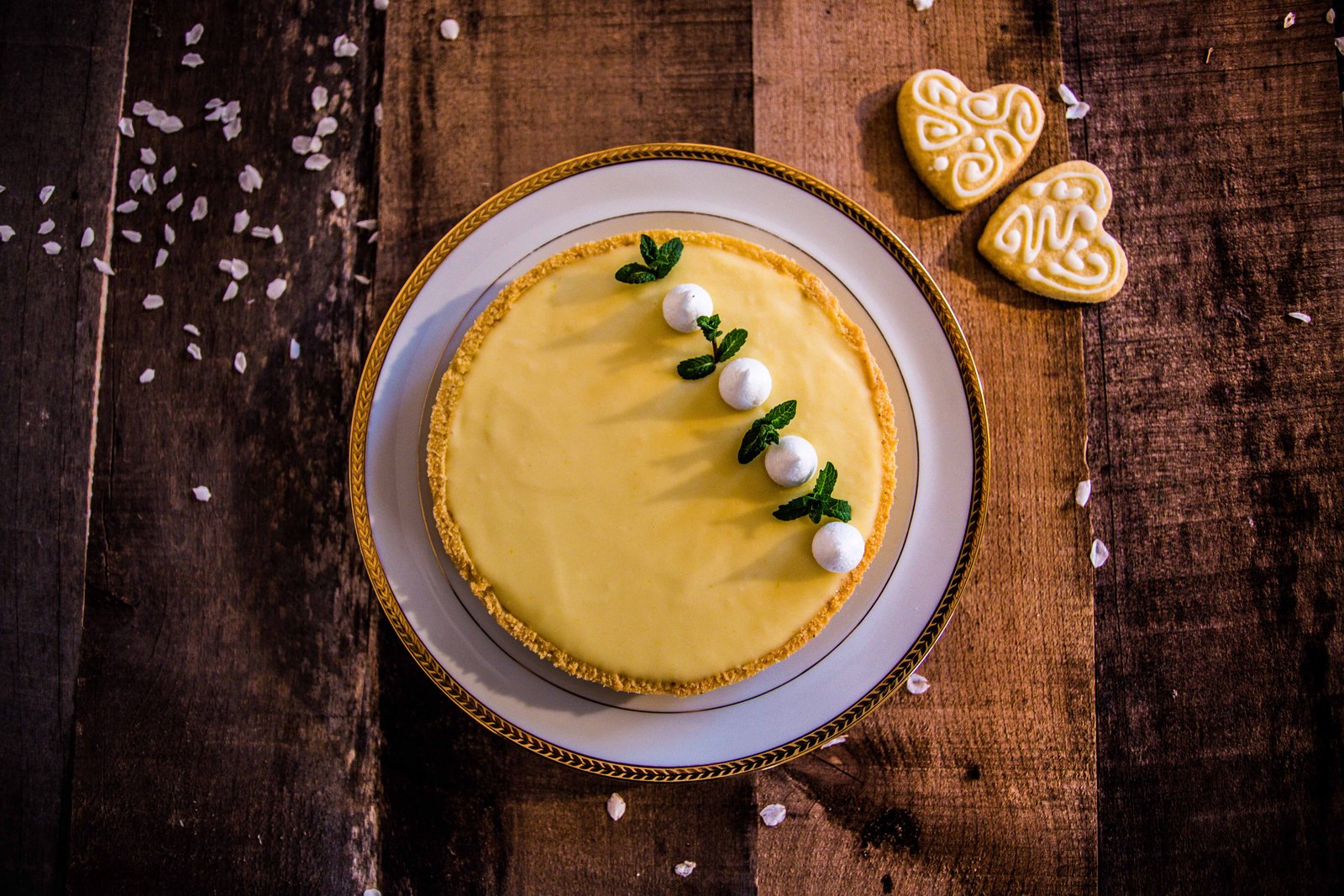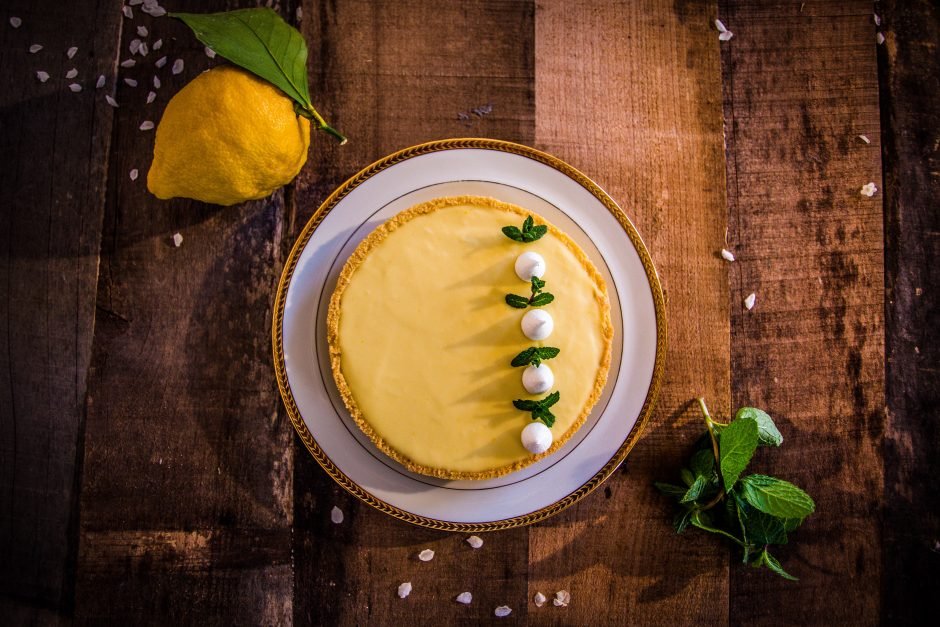(scroll down for english version)
Quando penso che la pasticceria è perfetto equilibrio di elementi mi torna alla mente il capolavoro in miniatura della Tarte lime e basilico del creatore francese Jacques Génin.
Sarà forse perché il ricordo è recente sulle mie papille?
La tarte era tra le proposte del giorno nella sua boutique al 133 di Rue de Turenne a Parigi insieme ad una serie di seducenti alternative che mi hanno fatto tentennare per diversi minuti. Poi ho rotto gli indugi e abbozzato un “ une tarte lime pour moi et la cheesecake pour le monsieur” (…che poi di solito le monsieur sono sempre io…).
La complessità della tarte, che pure si compone di due sole preparazioni, è data dalla realizzazione della pâte sucrée. L’elevata presenza di burro (oltre il 50% del peso della farina) rende la base estremamente friabile e al contempo delicata da lavorare. Impegnarsi però ne vale la pena: la sua fine opulenza è sostanziale per il raggiungimento dell’armonia finale del tutto o, per dirla alla Massari, per la “godibilità del prodotto”.
Questa tarte è perfetta se volete deliziare i vostri ospiti con un dessert originale, un sapore diretto ma anche semplice al palato. Al termine di una cena ricca e impegnativa, la tarte al lime et basilic lascerà un palato pulito grazie alla dolce acidità del lime. Potete preparare il guscio di pasta da cuocere e la crema la sera prima e ultimare la cottura ed il riempimento della tarte il giorno della cena.
“Credo che sia un artista chiunque sappia fare bene una cosa: cucinare, per esempio.”
(A. Warhol)

Tarte au citron verte et basilic di Jacques Génin
SUGGERIMENTI
1. Estraete il burro dal frigo 2 ore prima in quanto dev’essere morbido nel momento dell’utilizzo.
2. Quando tirate fuori il burro estraete anche le uova dal frigo, andranno leggermente sbattute prima del loro utilizzo.
3. La farina indicata da Genin è una T55 (secondo le classificazioni francesi) che va sostituita con una farina 0.
4. Per la cottura della frolla ho utilizzato un anello (senza base) con bordo leggermente arrotondato e alto circa 2 cm (acquistato in uno dei più vecchi negozi di articoli per la cucina e la pasticceria di Parigi, Dehillerin). Lo stampo è un vero e proprio un cerchio che, una volta foderato con la pasta (in francese Foncer), va ad appoggiarsi direttamente sul silpat o sulla carta da forno. Così si ottiene un guscio perfetto.
5. Se non avete molta abilità nell’infarinare le superfici e tendete a creare cumuli di farina che inevitabilmente alterano la composizione dell’impasto, suggerisco di utilizzare il setaccio. Tenetelo accanto a voi con della farina dentro e all’occorrenza fatene cadere un po’ sul piano di lavoro.
6. Il basilico può essere sostituito con altri aromi, per esempio la menta.
STRUMENTI
planetaria con foglia o frusta K
cerchio o anello basso per la cottura della base (vedi dettagli a seguire) diametro 24 cm e altezza 2 cm
mixer ad immersione
carta forno
spremiagrumi
chinois oppure colino similare
termometro da cucina

Tarte au citron verte et basilic di Jacques Génin
INGREDIENTI
Per la pâte sucrée (dose per due basi da 24 cm di diametro – potete congelare la rimanente)
175 g burro a temperatura ambiente
125 g zucchero a velo
30 g polvere di mandorle
60 g uova (1)
1/2 bacca di vaniglia o una punta di cucchiaino di vaniglia in polvere
2 gr sale
310 gr farina debole
Per il crémeux au citron vert et basilic
180 g di succo filtrato di 6/8 lime biologici o con buccia edibile (o 10 lime se piccoli) e le loro zeste
170 g zucchero
20 g basilico
3 uova
200 g burro morbido
PROCEDIMENTO
Per la pâte sucrée
Estraete la polpa della bacca di vaniglia e inseritela nel burro ammorbidito. Inserite quindi nella planetaria (o nel robot) il burro, lo zucchero a velo setacciato e la farina di mandorle e sbattete con la frusta K oppure la foglia fino ad ottenere un composto cremoso.
Aggiungete gradualmente le uova sbattute e il sale e continuate a sbattere senza montare fino a che gli ingredienti saranno ben amalgamati. Se necessario, aiutandovi con una spatola, staccate l’impasto che dovesse depositarsi sui bordi della ciotola e riavviate la planetaria.
Aggiungete in una sola volta la farina e amalgamate per breve tempo, solo quello necessario alla formazione della palla. Saranno sufficienti pochi secondi, appena si formano le briciole spegnete, raccogliete la pasta così formata su un foglio di carta da forno, appiattite leggermente, ponete sopra un altro foglio di carta e riponete in frigorifero a riposare per una notte. L’impasto ha necessità di stabilizzarsi.
Estraete la pasta e stendetela con il mattarello su una superficie leggermente infarinata fino a raggiungere un’altezza di circa 4 mm se fate delle torte, 3 mm se fate delle cartellette.
Poggiate con delicatezza il disco di acciaio sopra la pasta stesa e con un coltello incidete la pasta girando intorno al cerchio a una distanza di circa 3 cm.
Togliete poi il cerchio, sollevate la pasta stesa con delicatezza aiutandovi se necessario con il mattarello (arrotolandola delicatamente), distendetela su un silpat o un foglio di carta da forno e riponetela in frigo a indurirsi per circa 1 ora e 30 minuti.
Trascorso il tempo estraetela e appoggiatela delicatamente sopra l’anello in acciaio leggermente imburrato e appoggiato su una teglia coperta di carta da forno o silpat. Fate scendere la pasta delicatamente lungo i bordi del cerchio e aiutandovi con il pollice assicuratevi che aderisca bene lungo i bordi dello stampo. Non deve esserci aria. Rifinite poi l’eccesso di pasta che dovesse essere rimasto sui bordi passando un coltello lungo il bordo del cerchio. Il risultato sarà più preciso ed elegante.
Prima di infornare nuovamente consiglio di fare un altro passaggio in frigo fino a nuovo raffreddamento. Punzecchiate la base e i bordi con una forchetta per evitare che si gonfi in cottura.
Ponete un foglio di alluminio dentro la torta in modo tale da coprire bene la base e riempite con del riso oppure dei fagioli.
Infine, infornate e cuocete a 160°. Dopo circa 13 minuti estraete la torta dal forno, rimuovete delicatamente riso e alluminio e continuate la cottura per altri 8/10 minuti circa.
Se la base vi sembra troppo chiara continuate la cottura per il tempo necessario.
Se realizzate delle cartellette il tempo di cottura potrebbe essere inferiore.
Per il crémeux au citron vert et basilic
In una casseruola mescolate insieme tutti gli ingredienti eccetto il burro.
Portate a cottura dolcemente senza a mai superare gli 85° (altrimenti le uova coaguleranno e il tutto sarà da rifare).
Quando sarete vicini alla temperatura togliete dal fuoco passate subito il composto nello chinoise (o in un colino) direttamente in una ciotola.
Lasciate raffreddare fino a 40-45°, il che avverrà in circa 5 minuti.
Incorporate in una sola volta il burro a pezzetti, mescolate, quindi emulsionate con l’aiuto del mixer ad immersione per avere una crema più liscia e omogenea. Lasciate rassodare in frigorifero per almeno 3 ore, preferibilmente per una notte intera.
Composizione della tarte
Qualche ora prima di servire, riempite il guscio con la crema lisciando bene in modo tale da avere una superficie omogenea e completate, come prevedere la ricetta originale, con una grattugiata di lime.
Vista la semplicità estetica della Tarte au citron verte et basilic di Jacques Génin, trovo piacevole l’idea di impreziosirla lateralmente con qualche piccola meringa e dei ciuffetti di menta o basilico.
***

Tarte lime and basil by Jacques Génin
english version
When I think that baking is a perfect balance of elements, I remember the miniature masterpiece that is the Lime and Basil Tarte by French chef Jacques Génin. Maybe because its memory is still fresh on my taste buds? The tarte was among the specials of the day in his boutique at 133 Rue de Turenne in Paris, together with a series of enticing alternatives that made me hesitate for several minutes.
Finally I made up my mind and attempted a “ une tarte lime pour moi et la cheesecake pour le monsieur” (…although generally the monsieur turns out to be me…). The complexity of this tarte, despite having just two main components, is linked to the preparation of the pâte sucrée. Because of the quantity of butter (over 50% of the flour’s weight), the base is extremely crumbly and at the same time hard to knead.
However this tarte is worth the challenge: its elegant richness is essential to achieve the final harmony of the whole, or, to quote our Iginio Massari, for the “enjoyment of the product”. This tarte is perfect if you want to delight your guests with an unconventional dessert, a flavour that is direct and yet simple on the palate. At the end of a rich and demanding dinner, the Lime and Basil Tarte will leave the palate clean, thanks to the sweet acidity of the lime. You can prepare the uncooked pastry shell and the cream the night before, leaving just the cooking and the filling of the tarte for the day of your dinner.
TIPS
1. Take the butter out of the fridge two hours beforehand: it must be soft before you start using it.
2. The same applies to the eggs. They must be lightly beaten before using them.
3. To cook the pastry I used a ring-shaped mould (without base, with slightly rounded edges, approximately 2 cm high, bought in Dehillerin (one of the oldest cookware and pastry tools shops in Paris). The mould is simply a circle which, once lined with pastry (or Foncer in French), is positioned directly onthe silpat or the baking paper, in order to obtain a perfect shell.
4. Unless you’re an expert in dusting the surface with flour, to avoid flour lumps that will inevitably alter the pastry, I recommend to use a sieve. Keep it nearby with some flour in it and use it to dust the plan as required.
6. The basil can be substituted with a different aromatic herb, such as mint.
EQUIPMENT
Food mixer with silicone beater or whisk
Circle low ring to cook the base (see below) 24 cm diam. * 2 cm
Hand blender
Baking paper
Citrus juicer
Chinois or similar strainer
Cooking thermometer
INGREDIENTS
For the pâte sucrée (quantities for two 24 cm tart tins, you can freeze any dough you have left over)
175 g butter at room temperature
125 g icing sugar
30 g finely ground almonds
60 g eggs (1)
1/2 vanilla pod or the tip of a teaspoon of vanilla powder
2 g salt
310 g weak flour
For the lime and basil cream
180 g filtered juice and zest of 6/8 organic limes, with edible zest (or 10 if small)
170 g castor sugar
20 g basil
3 eggs
200 g butter, softened
METHOD
For the pâte sucrée
Scoop out the seeds from the vanilla pod and add them to the softened butter. Add the butter, sugar and almond flour into the bowl of the food mixer and whizz together using the silicone beater or balloon whisk until they form a creamy mixture. Gradually add the salt and the eggs, previously beaten, until all ingredients are well combined. If required, using a spatula, remove any dough stuck to the sides of the bowl and then blitz it back into the mixture.
Add all the flour and mix briefly, in order to obtain a ball of dough. It will take only a few seconds; once crumbles start to form, turn off the food mixer, get the dough and place it into a sheet of baking paper, flatten it slightly, add a second sheet of baking paper on top and leave it in the fridge overnight. The dough needs to stabilise.
Remove the dough from the fridge and roll it out on a lightly floured work surface until it is 4 mm thick if you are making tarts, or 3 mm if you are making tartlets. Carefully place the ring on top of the dough and cut it with a knife, approximately 3 cm away from the ring. Remove the circle and place it over the lined tray. Lift the dough carefully – delicately rolling it around a pin if required – place it over a sheet of baking paper and leave it in the fridge for approximately one hour 30 minutes.
After this time, remove it from the fridge and carefully place it over the ring mould, lightly greased with butter on a baking tray with the silpat or parchment paper. Lower the dough slowly along the rims of the ring; adjust it with your thumb so it sticks well to the mould. There should be no air. With a knife, trim the dough in excess and remove it from the mould’s edge. The final result will be more precise and elegant. Before baking it, I recommend to chill it again in the fridge. Pinch the bottom and the sides with a fork to prevent it from rising while it’s cooking. Line the chill pastry with aluminium foil and fill with beans or rice.
Bake in the oven at 160°. After 13 minutes, take the tart out of the oven, carefully remove the beans and the aluminium foil and then continue cooking for 8/10 minutes more. If the base’s colour looks too light, keep baking as required. If you’re making tartlets the baking time may be lower.
For the lime and basil cream
In a pan, mix together the remaining ingredients, with the exception of the butter. Cook slowly being carefully to always keep the temperature below 85° (otherwise eggs will solidify and you’ll need to start from scratch). When you are about to reach the 85°, remove the pan from the fire and pour the mixture through the chinois (or similar sieve) and into a bowl.
Let it cool down for approximately 54 minutes until it reaches a temperature of 40 – 45° C. Add all the butter, cut into cubes, at once and mix with the hand blender to obtain a smooth and uniform cream. Let it chill in the fridge for at least three hours, or preferably overnight.
Preparation of the tart
A few hours before serving, fill the tart with the cream and even it up to obtain a uniform, level surface. Finally, as per the original recipe, complete with a pinch of grated lime zest. Considering the simple look of the Lime and Basil Tarte by Jacques Génin, I like the idea of enriching its sides with a few little meringues and mint or basil leaves.







2 Commenti
[…] 1. Potete preparare la pâte sucrée beurrée anche diversi giorni prima e tenerla in congelatore. La sera prima di utilizzarla estraetela e ponetela in frigorifero. Poi procedete come indicato. Con la pasta avanzata potete realizzare per un’altra occasione questa ricetta. […]
[…] 1. You can prepare the pâte sucrée beurrée up to a few days beforehand, keeping it in the freezer. Move it from the freezer to the fridge the night before, then proceed as indicated in the recipe. Any leftovers can be used for a different recipe. […]